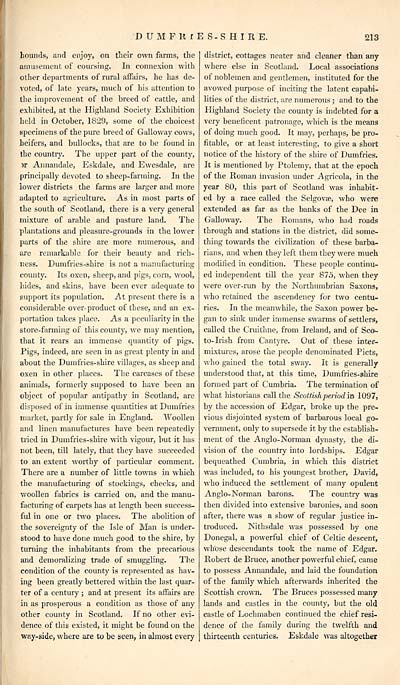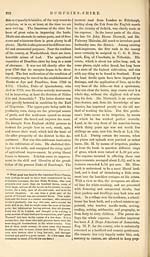Gazetteer of Scotland > Volume 1
(241) Page 213
Download files
Complete book:
Individual page:
Thumbnail gallery: Grid view | List view

DUMF1UES-SHIRE.
213
hounds, and enjoy, on their own farms, the
amusement of coursing. In connexion with
other departments of rural affairs, he has de-
voted, of late years, much of his attention to
the improvement of the breed of cattle, and
exhibited, at the Highland Society Exhibition
held in October, 1829, some of the choicest
specimens of the pure breed of Galloway cows,
heifers, and bullocks, that are to be found in
the country. The upper part of the county,
ir Annandale, Eskdale, and Ewesdale, are
principally devoted to sheep-farming. In the
lower districts the farms are larger and more
adapted to agriculture. As in most parts of
the south of Scotland, there is a very general
mixture of arable and pasture land. The
plantations and pleasure-grounds in the lower
parts of the shire are more numerous, and
are remarkable for their beauty and rich-
ness. Dumfries-shire is not a manufacturing
county. Its oxen, sheep, and pigs, corn, wool,
hides, and skins, have been ever adequate to
support its population. At present there is a
considerable over-product of these, and an ex-
portation takes place. As a peculiarity in the
store-farming of this county, we may mention,
that it rears an immense quantity of pigs.
Pigs, indeed, are seen in as great plenty in and
about the Dumfries-shire villages, as sheep and
oxen in other places. The carcases of these
animals, formerly supposed to have been an
object of popular antipathy in Scotland, are
disposed of in immense quantities at Dumfries
market, partly for sale in England. Woollen
and linen manufactures have been repeatedly
tried in Dumfries-shire with vigour, but it has
not been, till lately, that they have succeeded
to an extent worthy of particular comment.
There are a number of little towns in which
the manufacturing of stockings, checks, and
woollen fabrics is carried on, and the manu-
facturing of carpets has at length been success-
ful in one or two places. The abolition of
the sovereignty of the Isle of Man is under-
stood to have done much good to the shire, by
turning the inhabitants from the precarious
and demoralizing trade of smuggling. The
condition of the county is represented as hav-
ing been greatly bettered within the last quar-
ter of a century ; and at present its affairs are
in as prosperous a condition as those of any
other county in Scotland. If no other evi-
dence of this existed, it might be found on the
way-side, where are to be seen, in almost every
district, cottages neater and cleaner than any
where else in Scotland. Local associations
of noblemen and gentlemen, instituted for the
avowed purpose of inciting the latent capabi-
lities of the district, are numerous ; and to the
Highland Society the county is indebted for a
very beneficent patronage, which is the means
of doing much good. It may, perhaps, be pro-
fitable, or at least interesting, to give a short
notice of the history of the shire of Dumfries.
It is mentioned by Ptolemy, that at the epoch
of the Roman invasion under Agricola, in the
year 80, this part of Scotland was inhabit-
ed by a race called the Selgovae, who were
extended as far as the banks of the Dee in
Galloway. The Romans, who had roads
through and stations in the district, did some-
thing towards the civilization of these barba-
rians, and when they left them they were much
modified in condition. These people continu-
ed independent till the year 875, when they
were over-run by the Northumbrian Saxons,
who retained the ascendency for two centu-
ries. In the meanwhile, the Saxon power be-
gan to sink under immense swarms of settlers,
called the Cruithne, from Ireland, and of Sco-
to-Irish from Cantyre. Out of these inter-
mixtures, arose the people denominated Picts,
who gained the total sway. It is generally
understood that, at this time, Dumfries-shire
formed part of Cumbria. The termination of
what historians call the Scottish period in 1097,
by the accession of Edgar, broke up the pre-
vious disjointed system of barbarous local go-
vernment, only to supersede it by the establish-
ment of the Anglo-Norman dynasty, the di-
vision of the country into lordships. Edgar
bequeathed Cumbria, in which this district
was included, to his youngest brother, David,
who induced the settlement of many opulent
Anglo-Norman barons. The country was
then divided into extensive baronies, and soon
after, there was a show of regular justice in-
troduced. Nithsdale was possessed by one
Donegal, a powerful chief of Celtic descent,
whose descendants took the name of Edgar.
Robert de Bruce, another powerful chief, came
to possess Annandale, and laid the foundation
of the family which afterwards inherited the
Scottish crown. The Bruces possessed many
lands and castles in the county, but the old
castle of Lochmaben continued the chief resi-
dence of the family during the twelfth and
thirteenth centuries. Eskdale was altogether
213
hounds, and enjoy, on their own farms, the
amusement of coursing. In connexion with
other departments of rural affairs, he has de-
voted, of late years, much of his attention to
the improvement of the breed of cattle, and
exhibited, at the Highland Society Exhibition
held in October, 1829, some of the choicest
specimens of the pure breed of Galloway cows,
heifers, and bullocks, that are to be found in
the country. The upper part of the county,
ir Annandale, Eskdale, and Ewesdale, are
principally devoted to sheep-farming. In the
lower districts the farms are larger and more
adapted to agriculture. As in most parts of
the south of Scotland, there is a very general
mixture of arable and pasture land. The
plantations and pleasure-grounds in the lower
parts of the shire are more numerous, and
are remarkable for their beauty and rich-
ness. Dumfries-shire is not a manufacturing
county. Its oxen, sheep, and pigs, corn, wool,
hides, and skins, have been ever adequate to
support its population. At present there is a
considerable over-product of these, and an ex-
portation takes place. As a peculiarity in the
store-farming of this county, we may mention,
that it rears an immense quantity of pigs.
Pigs, indeed, are seen in as great plenty in and
about the Dumfries-shire villages, as sheep and
oxen in other places. The carcases of these
animals, formerly supposed to have been an
object of popular antipathy in Scotland, are
disposed of in immense quantities at Dumfries
market, partly for sale in England. Woollen
and linen manufactures have been repeatedly
tried in Dumfries-shire with vigour, but it has
not been, till lately, that they have succeeded
to an extent worthy of particular comment.
There are a number of little towns in which
the manufacturing of stockings, checks, and
woollen fabrics is carried on, and the manu-
facturing of carpets has at length been success-
ful in one or two places. The abolition of
the sovereignty of the Isle of Man is under-
stood to have done much good to the shire, by
turning the inhabitants from the precarious
and demoralizing trade of smuggling. The
condition of the county is represented as hav-
ing been greatly bettered within the last quar-
ter of a century ; and at present its affairs are
in as prosperous a condition as those of any
other county in Scotland. If no other evi-
dence of this existed, it might be found on the
way-side, where are to be seen, in almost every
district, cottages neater and cleaner than any
where else in Scotland. Local associations
of noblemen and gentlemen, instituted for the
avowed purpose of inciting the latent capabi-
lities of the district, are numerous ; and to the
Highland Society the county is indebted for a
very beneficent patronage, which is the means
of doing much good. It may, perhaps, be pro-
fitable, or at least interesting, to give a short
notice of the history of the shire of Dumfries.
It is mentioned by Ptolemy, that at the epoch
of the Roman invasion under Agricola, in the
year 80, this part of Scotland was inhabit-
ed by a race called the Selgovae, who were
extended as far as the banks of the Dee in
Galloway. The Romans, who had roads
through and stations in the district, did some-
thing towards the civilization of these barba-
rians, and when they left them they were much
modified in condition. These people continu-
ed independent till the year 875, when they
were over-run by the Northumbrian Saxons,
who retained the ascendency for two centu-
ries. In the meanwhile, the Saxon power be-
gan to sink under immense swarms of settlers,
called the Cruithne, from Ireland, and of Sco-
to-Irish from Cantyre. Out of these inter-
mixtures, arose the people denominated Picts,
who gained the total sway. It is generally
understood that, at this time, Dumfries-shire
formed part of Cumbria. The termination of
what historians call the Scottish period in 1097,
by the accession of Edgar, broke up the pre-
vious disjointed system of barbarous local go-
vernment, only to supersede it by the establish-
ment of the Anglo-Norman dynasty, the di-
vision of the country into lordships. Edgar
bequeathed Cumbria, in which this district
was included, to his youngest brother, David,
who induced the settlement of many opulent
Anglo-Norman barons. The country was
then divided into extensive baronies, and soon
after, there was a show of regular justice in-
troduced. Nithsdale was possessed by one
Donegal, a powerful chief of Celtic descent,
whose descendants took the name of Edgar.
Robert de Bruce, another powerful chief, came
to possess Annandale, and laid the foundation
of the family which afterwards inherited the
Scottish crown. The Bruces possessed many
lands and castles in the county, but the old
castle of Lochmaben continued the chief resi-
dence of the family during the twelfth and
thirteenth centuries. Eskdale was altogether
Set display mode to: Large image | Transcription
Images and transcriptions on this page, including medium image downloads, may be used under the Creative Commons Attribution 4.0 International Licence unless otherwise stated. ![]()
| Gazetteers of Scotland, 1803-1901 > Gazetteer of Scotland > Volume 1 > (241) Page 213 |
|---|
| Permanent URL | https://digital.nls.uk/97427254 |
|---|
| Description | Volume I: Abbey to Glenartney. |
|---|---|
| Attribution and copyright: |
|
| Description | By Robert Chambers and William Chambers. Glasgow: Blackie & Son, 1838. 2 volumes. |
|---|---|
| Shelfmark | NF.1461.g.7 |
| Additional NLS resources: | |

